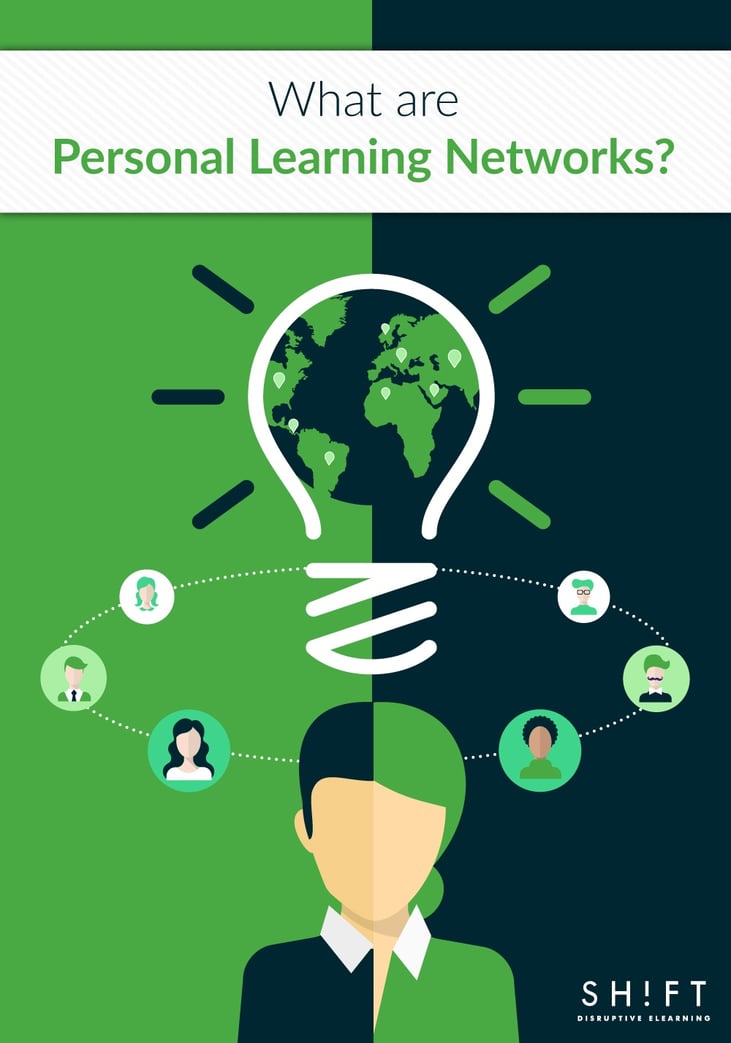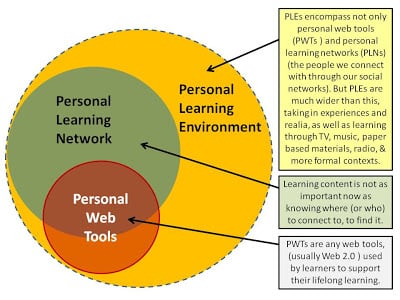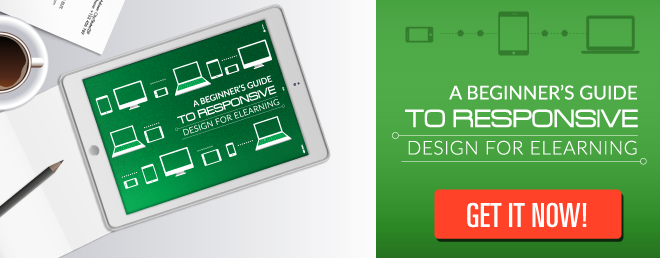If you assume students are only learning from eLearning courses, you are failing to leverage a huge part of the learning process.
Ask yourself where do you learn?
Most of us might answer “in a classroom”, but, in reality, the majority of learning comes from other places, like Personal Learning Networks. And these networks are personal, meaning there are no two PLNs that are equal; each of us has a unique range of people we learn from including peers, coworkers, supervisors, experts and other professionals. Today more learners use tools like Google and Wikipedia to acquire new skills and knowledge. They subscribe to personal and professional blogs. Or they ask questions through their social media networks to get the most relevant answers from the members of their PLN.

Defining PLN's
PLN stands for Personal Learning Network. It has a range of definitions but here is one that suits our purposes best: “A network of trusted connections with whom an individual interacts (and learns from) on a regular basis.” - Jane Hart.
In other words, your PLN is where you gather, collect, communicate, create and also share knowledge and experience with a group of connected people, anywhere at any time. It is developed largely through social media, such as Twitter, LinkedIn, Facebook, and blogs, helping us form connections, grow our knowledge base and develop ourselves professionally through continual learning.
A PLN is further defined by intention. When someone makes a connection with the particular purpose of learning and gaining information from that person. This differs from merely meeting someone at random who you may form a friendship with. While you can have friends within your PLN, not all people within your PLN are people you would invite over for a BBQ or out to a bar.
PLNs are not new, but technology has, however, changed how we connect to others and have expanded their reach significantly. Social media and technology have, specifically, removed the physical barriers that once existed. Time zones and distance no longer present the significant hurdles they once did. With the multitude of social platforms and communication apps like Skype, GoToMeeting and Face Time there are very few things you can’t do long distance.
Relationship Building through Technology
Even though we talk about technology with PLNs, they are much more about the connections and relationships we make.
According to EdWeek, to conceptualize a PLN, you should envision three layers, with ourselves at the center. The closest and smallest ring include friends and personal mentors. The next layer includes groups that share our interests but are not necessarily close friends. The final layers include experts, professionals, and celebrities. People who may not have much, if any personal interaction but who we still look up to and learn from.
What Does a PLN Do?
A PLN must serve three purposes in order to make other events in the network possible. These are:
- Connection Building: a PLN adds new people to gain further knowledge resources for when they are needed.
- Connection Maintenance: a PLN keeps you in touch with relevant people.
- Connection Activation: a PLN activates connections with select people to allow for new learning. (Nardi, et al., 2000; Nardi, et al., 2002).
What a PLN is Not
PLNs and CoPs (Communities of Practice) are often used interchangeably; we could be forgiven for thinking that they are more or less synonymous. But, a PLN is not a CoP. With CoPs, the people who make up the community have a profession or professional field in common. A network though is markedly different in that it is made up of individuals who form individual connections that are not based on a single profession.
PLN connections are random and mostly informal, while CoP connections are more formal or structured since they require the common thread of professional expertise. CoPs are a resource about the shared professional field where members can give and take the info to benefit the group as a whole. PLNs are less focused, typically because they involve a much broader range of people with varying levels and kinds of expertise.
Further Reading:
PLN is not PLE
A PLE or Personal Learning Environment is not the same as a PLN either. PLEs are self-directed learning spaces, which contain tools to gather, organize and create knowledge that is specialized to an individual’s goals and needs.
A PLN is a part of a PLE when a person has a group within their professional network that has a unifying factor such as common interest, project or goal. Social media and networking helps create these connections and furthers the spreading of information.
A PLE, in short, is much broader than a PLN including all the people in a PLN and the content that is generated through it. It is also more than the various tools that students use to research, write, access, and spread content with.
A PLE can be created when an eLearning course’s VLE (Virtual Learning Environment) adds tools or applications that allow students to control their learning. So, in this way, a Personal Learning Environment is what comes about when a Virtual Learning Environment is personalized for users to direct themselves within the environment. Adding social elements where students can interact with each other within a PLE, turns it into a PLN.

Image Source: The Anatomy of a PLE
Why Building a PLN is Increasingly Important
The way we learn and interact in our current era of networking is defined and theorized upon by Connectivism. Connectivism shows us that a PLN is a person’s way to get a continuous stream of knowledge and space to exchange thoughts and ideas while receiving validation of their contributions to the network and the challenges they rise to.
This is relevant to organizations because it is impossible to provide training for every single required skill that will be needed to perform a task or job. Training can only be provided for known duties but for all the unknowns, innovation and the ability to adapt, are the only ways to success. To makes this possible PLNs:
- Give members several information sources and pathways.
- Constructing your own PLN is a new way to develop yourself professionally with a network that caters to your needs and is available when you require it.
- Help you stay up-to-date by providing the most current information from experts within your field
- Provide a continuous stream of learning, resources and ways of thinking about topics that matter to you.
- Help you find answers and advice when you need it because your online network always has someone available.
- Increase your reach due to the technology involved in PLNs. Even persons who live and work remotely can make connections across the country or globe.
- Allow you to gain information from things like workshops and conferences even when you are unable to physically attend them. Technology allows many of these learning events to be streamed live.
- Expand your thinking by engaging in active discussion.
- Acquire expert advice almost on demand since you are no longer limited to getting info from infrequently published texts and scholarly articles. Professionals and thought leaders in your field are continuously providing insights through their PLN and social media.
Want to start building your own PLN? Watch this video.
REFERENCES:
1. Learning in the Modern Workplace by Jane Hart. http://www.slideshare.net/janehart/learning-in-the-modern-workplace-43899391/19-mobile_content_mobile_rstmicro
2. I Believe in the Importance of a Personal Learning Network by Tom Spiglanin http://tom.spiglanin.com/2014/12/i-believe-in-the-importance-of-a-personal-learning-network/
3. Personal Learning Networks: Learning in a Connected World. ID and Other Reflections Blog http://idreflections.blogspot.com/2015/01/personal-learning-networks-for-ongoing.html
4. How to Create a Robust and Meaningful Personal Learning Network [PLN] by Online Learning Insights https://onlinelearninginsights.wordpress.com/2013/01/22/how-to-create-a-robust-and-meaningful-personal-learning-network-pln/
5. The Future of Work and Learning 1: The Professional Ecosystem by Jane Hart http://www.c4lpt.co.uk/blog/2016/05/08/the-professional-ecosystem-the-future-of-work-and-learning/
6. Learning Design and Personal Learning Networks by Joyce Seitzinger http://www.slideshare.net/catspyjamas/rmit-what-onearthaug2014
7. Seek, Sense, Share: Understanding the Flow of Information Through a Personal Learning Network http://www.lifewideeducation.uk/blog/category/personal-learning-networks
8. What is a PLN? Or, PLE vs. PLN? http://educationaltechnology.ca/couros/1156
9. Personal Learning Network Model http://firstmonday.org/ojs/index.php/fm/article/view/3559/3131



